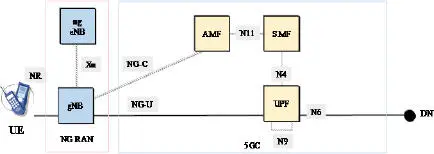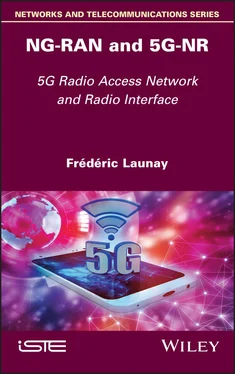The NG interface is the point of reference between the NG-RAN and the 5G core network:
1 – the NG-C interface is the interface between the radio node and the AMF (Access and Mobility Management Function). It supports signaling via NG-AP (Next Generation Application Protocol);
2 – the NG-U interface is the interface between the radio node and the UPF (User Plane Function) for tunneling traffic (the IP packet) via GTP-U (GPRS Tunneling Protocol).
The UPF is configured by the SMF (Session Management Function) under the control of the AMF.

Figure 1.6. NG-RAN general architecture
The mobile exchanges data with the DN (Data Network) through logical connections called PDU (Protocol Data Unit) sessions. This logical connection is divided into two parts:
1 – the NG-RAN ensures the connection of the mobiles with the base station and interconnects the control plane and user plane (traffic) of the mobile UE with the core network;
2 – the 5G core network interconnects the NG-RAN, provides the interface to the DN, ensures the registration of mobiles, the monitoring of their mobility and the establishment of data sessions with the quality of the corresponding QoS (Quality of Service).
The NG-RAN provides both an LTE radio interface and a 5G-NR radio interface.
An NG-RAN node is:
1 – a 5G base station (gNB), which provides the control plane services and the transmission of user plane data through the 5G-NR radio interface;
2 – an advanced 4G base station (ng-eNB), providing control plane services and data transmission from the user plane to mobiles via the LTE radio interface.
The NG-RAN node is responsible for managing radio resources, controlling the radio bearer establishment of the user plane and managing mobility during the session (handover). The mobile connects to one of the radio nodes.
The NG-RAN node transfers the traffic data from the mobile to the UPF and data from the UPF to the mobile.
When the NG-RAN node receives data from the mobile or from the UPF, it refers to the QFI (QoS Flow Identifier) for the implementation of the data scheduling mechanism.
For outgoing data to the UPF entity, the NG-RAN node performs the marking of the DSCP (DiffServ Code Point) field of the IP (Internet Protocol) header, based on the assigned QFI.
The NG-RAN node performs compression and encryption of traffic data on the radio interface. It can also optionally perform the integrity control of the traffic data exchanged with the mobile.
The NG-RAN node performs the encryption and integrity control of the signaling data exchanged with the mobile on the radio interface.
The NG-RAN node performs the selection of the AMF. The AMF is the function of the core network to which the mobile UE is attached.
The NG-RAN broadcasts the RRC paging received from the AMF.
The NG-RAN node also broadcasts the cell’s system information, containing the radio interface characteristics. The devices use these parameters for cell selection and for radio bearer establishment requests.
When a mobile is connected, the NG-RAN uses the measurements made by the mobile to decide on the initiation of a cell change during a session (handover).
In order to manage the services for each connected mobile, the NG-RAN node maintains a UE context information block relating to each mobile. The information saved by the radio node may depend on the mobile usage.
The mobile is either in the RRC connected state (RRC_CONNECTED), the RRC inactive state (RRC_INACTIVE) or the standby RRC state (RRC_IDLE).
When the mobile enters the standby state, the base station is not aware of its presence. Each mobile in the standby state listens to the information broadcasts by the radio node.
There is no UE context at the radio node for the mobile in the RRC_IDLE state.
When the mobile enters the RRC_CONNECTED state or the RRC_INACTIVE state, a mobile radio identifier C-RNTI or I-RNTI, respectively, (Connected/Inactive Radio Network Temporary Identifier) is saved at the radio node. The context of the UE is saved in relation to the RNTI. The context is recorded at the level of the NG-RAN node, which manages the mobile (source node), and it is transmitted to the target node in the event of a handover. The UE context is also created at the level of the MN and at the level of the SN in the event of dual connectivity.
When a mobile is in the connected mode, the NG-RAN node uses measurements made by the mobile to decide whether to trigger a change of node during the session (handover) or to activate or deactivate secondary cells.
1.2.2. AMF (Access management and Mobility Function)
The AMF (Access management and Mobility Function) supports:
1 – the registration of the mobile;
2 – the access control and the management of mobility on both the NG-RAN and Wi-Fi network access (non-3GPP access);
3 – network slicing.
The mobile and the AMF exchange data using the NAS (Non-Access Stratum) protocol.
The registration function allows the attachment of the mobile, the detachment of the mobile and the update of its location.
During the attachment, the AMF records the TAI (Tracking Area Identity) location and private identity of the mobile and assigns a 5G-GUTI (5G Globally Unique Temporary Identifier) to the mobile.
5G-GUTI replaces the encrypted private identifier SUCI (Subscription Concealed Identifier) and the private identifier SUPI (Subscription Private Identifier).
Once the attachment procedure is completed, the AMF selects the SMF, according to the DNN (Data Network Name) and the network slice indicator NSSAI (Network Slice Selection Assistance Information).
A load balancing procedure is applied when different SMF can be selected.
The DNN is either communicated by the mobile to the AMF during attachment, or retrieved from the subscriber’s profile from the UDR (Unified Data Repository).
The AMF manages a list of TAIs allocated to mobiles, in which the mobile, in the standby state, can move without contacting the AMF to update its location.
The AMF manages the addition and removal of the TNL (Transport Network Layer) association with the entities of the NG-RAN node. In the event of a handover, the source AMF will release the TNL association with the source NG-RAN node and redirect the TNL association to the target NG-RAN node.
1.2.3. SMF (Session Management Function)
The SMF (Session Management Function) is responsible for creating, updating and removing PDU (Protocol Data Unit) sessions and managing session context with the UPF (User Plane Function). The SMF injects routing rules to the selected UPFs.
A routing rule corresponds to an entry in the context table of the UPF. This context table contains four fields:
1 – a correspondence field (PDR (Packet Detection Rule));
2 – a routing field NH (next hop: IP address, tunnel number TEID (Tunnel End Identifier) or SR (Segment Routing)) to find the next node;
3 – the quality of service to be applied to the flow (QER (QoS Enhancement Rules));
4 – the measurement reports to be applied to the flow (URR (Usage Reporting Rules)).
The SMF is responsible for the session management for each DNN and by network slice (S-NSSAI), based on the user profile stored at the UDR.
When requesting a session to be established, the SMF selects a UPF or queries the NRF (Network Repository Function) to obtain the address of the UPF.
The SMF grants an IPv4 or IPv6 address to the mobile. An IP address is provided for each PDU session, based on the address range of the PSA (PDU Session Anchor) selected to join the IP data network. The address range is obtained by either directly querying the selected UPF or by querying the NRF. If the assigned IPv4 address is a private address, the UPF entity performs NAPT (Network Address and Port Translation) in order to translate the IP address and TCP (Transmission Control Protocol) or UDP (User Datagram Protocol) port numbers.
Читать дальше













